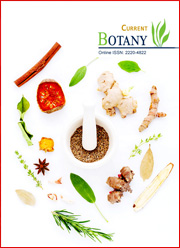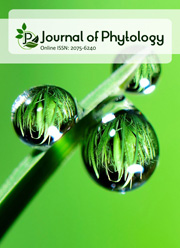In silico molecular docking and in vitro antimicrobial efficacy of phytochemical compounds of Lantana camara Linn.
DOI:
https://doi.org/10.25081/cb.2023.v14.8002Keywords:
Lantana camara, molecular docking, antimicrobial activity, phytochemical compounds, Escherichia coli, GC-MS analysisAbstract
The rise of multi-drug resistant bacteria and the extensive use of antibiotics has become a serious threat worldwide. The side effect of antibiotics swirled the researchers towards traditional medicine to find a therapeutic agent with antibacterial activity. The phytochemical compound from medicinal plants paves a way for the novel antibacterial agent. In the present study, in silico molecular docking of phytochemical compounds identified through GC-MS analysis and in vitro antibacterial efficacy of ethanolic leaf extract of Lantana camara were evaluated. In silico docking studies of 11 Phyto-ligands were carried out against 4 motifs- 1PHO, 5I5H, 5UW2 and 6NTW of Escherichia coli to estimate the binding energy and to know the protein-ligand interaction. Amongst all the phyto-ligands studied, 4,8,13-Cyclotetradecatriene-1,3-diol,1,5,9-trimethyl-12-(1-methylethyl) showed good affinity towards 1PHO, 4a(2H)-Phenanthrenecarboxaldehyde,1,3,4,9,10,10a-hexahydro-6-methoxy-1,1-dimethyl-7-(1-methylethyl) exhibited highest affinity with 5I5H motifs of E. coli, 4,8,13-Cyclotetradecatriene-1,3-diol, 1,5,9-trimethyl-12-(1-methylethyl) showed better affinity towards motif 5UW2 of E. coli and (Z)-4-Nitro-alpha-(p-nitrophenyl)cinnamic acid showed good affinity towards 6NTW motif of E. coli. The ethanolic leaf extract of L. camara L. showed concentration dependent activity against E. coli.
Downloads
References
Abdullahi, M., & Adeniji, S. E. (2020). In-silico molecular docking and ADME/ pharmacokinetic prediction studies of some novel carboxamide derivatives as anti-tubercular agents. Chemistry Africa, 3, 989-1000. https://doi.org/10.1007/s42250-020-00162-3
Aslam, B., Wang, W., Arshad, M. I., Khurshid, M., Muzammil, S., Rasool, M. H., Nisar, M. A., Alvi, R. F., Aslam, M. A., Qamar, M. U., Salamat, M. K. F., & Baloch, Z. (2018). Antibiotic resistance: a rundown of a global crisis. Infection and Drug Resistance, 11, 1645-1658. https://doi.org/10.2147/IDR.S173867
Badakhshan, M. P., Sreenivasan, S., Jegathambigai, R. N., & Surash, R. (2009). Antileukemia activity of methanolic extracts of Lantana camara. Pharmacognosy Research, 1(5), 274-279.
Bhakta, D., & Ganjewala, D. (2009). Effect of leaf positions on total phenolics, flavonoids and proanthocyanidins content and antioxidant activities in Lantana camara (L). Journal of Scientific Research, 1(2), 363-369. https://doi.org/10.3329/jsr.v1i2.1873
Canli, K., Altuner, E. M., & Akata, I. (2015). Antimicrobial screening of Mnium stellare. Bangladesh Journal of Pharmacology, 10(2), 321-325. https://doi.org/10.3329/bjp.v10i2.22463
Cowan, M. M. (1999). Plant Products as Antimicrobial Agents. Clinical Microbiology Reviews Journal, 12(4), 564-582. https://doi.org/10.1128/cmr.12.4.564
Dharmagada, V. S. S., Tandonb, M., & Vasudevan, P. (2005). Biocidal activity of the essential oils of Lantana camara, Ocimum sanctum and Tagetes patula. Journal of Scientific & Industrial Research, 64, 53-56.
El-Kassem, L. T. A., Mohammed, R. S., El-Souda, S. S., El- Anssary, A. A., Hawas, U. W., Mohmoud, K., & Farrag, A. R. H. (2014). Di galacturonide flavones from Egyptian Lantana camara flowers with in vitro antioxidant and in vivo hepatoprotective activities. Zeitschrift für Naturforschung C, 67(7-8), 381-390. https://doi.org/10.1515/znc-2012-7-805
Ganjewala, D., Sam, S., & Khan, K. H. (2009). Biochemical compositions and antibacterial activities of Lantana camara plants with yellow lavender, red and white flowers. Eurasian Journal of Biosciences, 3, 69-77.
Gomes de Melo, J., De Sousa Araújo, T. A., Thijan Nobre de Almeida e Castro, V., Lyra de Vasconcelos Cabral, D., Do Desterro Rodrigues, M., Carneiro do Nascimento, S., Cavalcanti de Amorim, E. L., & De Albuquerque, U. P. (2010). Antiproliferative activity, antioxidant capacity and tannin content in plants of semi-arid Brazil. Molecules, 15(12), 8534-8542. https://doi.org/10.3390/molecules15128534
Ibibia, E. T., Olabisi, K. N., & Oluwagbemiga, O. S. (2016). Gas chromatography-mass spectrometric analysis of methanolic leaf extracts of Lannea kerstingii and Nauclea diderrichii, two medicinal plants used for the treatment of gastrointestinal tract infections. Asian Journal of Pharmaceutical and Clinical Research, 9(4), 179-182.
Jeong, B. J., Hong, S. C., Jeong, H. J., & Koo, J. S. (2011). Anti-inflammatory effect of 2- methoxy-4-vinylphenol via the suppression of NF-κB and MAPK activation, and acetylation of histone H3. Archives of Pharmacal Research, 34, 2109-2116. https://doi.org/10.1007/s12272-011-1214-9
Jeong, J. B., & Jeong, H. J. (2010). 2-Methoxy-4-vinylphenol can induce cell cycle arrest by blocking the hyperphosphorylation of retinoblastoma protein in benzo [a] pyrene-treated NIH3T3 cells. Biochemical and Biophysical Research Communication, 400(4), 752-757. https://doi.org/10.1016/j.bbrc.2010.08.142
Jia, Z., Song, X., Shi, J., Wang, W., & He, K. (2020). Transcriptome-based drug repositioning for coronavirus disease 2019 (COVID-19). Pathogens and Disease, 78(4), ftaa036. https://doi.org/10.1093/femspd/ftaa036
Kalita, S., Kumar, G., Karthik, L., & Rao, K. V. B. (2011). Phytochemical composition and in-vitro haemolytic activity of Lantana camara L. (Verbenaceae) leaves. Pharmacologyonline, 1, 59-67.
Kaur, S., Kumar, S., Kaur, P., & Chandel, M. (2010). Study of antimutagenic potential of phytoconstituents isolated from Terminalia arjuna in the Salmonella/Microsome Assay. American Journal of Biomedical Sciences, 2(2), 164-177. https://doi.org/10.5099/AJ100200164
Kim, M.-G., & Lee, H.-S. (2014). 1,2-Benzendiol isolated from persimmon roots and its structural analogues show antimicrobial activities against food-borne bacteria. Journal of the Korean Society for Applied Biological Chemistry, 57, 429-433. https://doi.org/10.1007/s13765-014-4141-x
Kumar, M. S., & Maneemegalai, S. (2008). Evaluation of larvicidal effect of Lantana camara Linn against mosquito species Aedes aegypti and Culex quinquefasciatus. Advances in Biological Research, 2(3-4), 39-43.
Lugtenberg, B., & Alphen, L. V. (1983). Molecular architecture and functioning of the outer membrane of Escherichia coli and other gram-negative bacteria. Biochimica et Biophysica Acta (BBA) – Reviews on Biomembranes, 737(1), 51-115. https://doi.org/10.1016/0304-4157(83)90014-x
Miri, S. T., Dashti, A., Mostaan, S., Kazemi, F., & Bouzari, S. (2017). Identification of different Escherichia coli pathotypes in north and north-west provinces of Iran. Iranian Journal of Microbiology, 9(1), 33-37.
Munir, A. A. (1996). A revision taxonomic of Lantana camara L. and L. montevidensis Briq.(Verbenaceae) in Australia. Journal of the Adelaide Botanic Gardens, 17, 1-27.
Nikaido, H., & Vaara, M. (1985). Molecular basis of bacterial outer membrane permeability. Microbiology and Molecular Biology Reviews, 49(1), 1-32. https://doi.org/10.1128/mr.49.1.1-32.1985
Patel, J., Kumar, G. S., Deviprasad, S. P., Deepika, S., & Qureshi, M. S. (2011). Phytochemical and antihelmintic evaluation of Lantana camara (L.) var. aculeate leaves against Pheretima posthuma. Journal of Global Trends in Pharmaceutical Sciences, 2(1), 11-20.
Pinzi, L., & Rastelli, G. (2019). Molecular docking: Shifting paradigms in drug discovery. International Journal of Molecular Sciences, 20(18), 4331. https://doi.org/10.3390/ijms20184331
Prasad, M. A., Zolnik, C. P., & Molina, J. (2019). Leveraging phytochemicals: the plant phylogeny predicts sources of novel antibacterial compounds. Future Science OA, 5(7), FSO407. https://doi.org/10.2144/fsoa-2018-0124
Raghu, C., Ashok, G., Dhanaraj, S. A., Suresh, B., & Vijayan, P. (2004). In vitro cytotoxic activity of Lantana camara Linn. Indian Journal of Pharmacology, 36(2), 94-95.
Rahuman, A. A., Gopalakrishnan, G., Ghouse, B. S., Arumugam, S., & Himalayan, B. (2011). Effect of Feronia limonia on mosquito larvae. Fitoterapia, 71(5), 553-555. https://doi.org/10.1016/S0367-326X(00)00164-7
Shah, S. M. M., Khan, F. A., Shah, S. M. H., Chishti, K. A., Pirzada, S. M. S. S., Khan, M. A., & Farid, A. (2011). Evaluation of phytochemicals and antimicrobial activity of white and blue capitulum and whole plant of Silybum marianum. World Applied Sciences Journal, 12(8), 1139-1144.
Swamy, M. K., Sinniah, U. R., & Akhtar, M. S. (2015). In Vitro Pharmacological Activities and GC-MS Analysis of Different Solvent Extracts of Lantana camara Leaves Collected from Tropical Region of Malaysia. Evidence-Based Complementary and Alternative Medicine, 2015, 506413. https://doi.org/10.1155/2015/506413
Thamotharan, G., Sekar, G., Ganesh, T., Sen, S., Chakraborty, R., & Kumar, N. S. (2010). Antiulcerogenic effects of Lantana camara Linn. leaves on in vivo test models in rats. Asian Journal of Pharmaceutical and Clinical Research, 3(4), 57-60.
Villegas, M. V., & Quinn, J. P. (2004). An update on antibiotic-resistant gram-negative bacteria. Infections in Medicine, 21(12), 595-599.
Vogel, A. I. (1978). A Text Book of Practical Organic Chemistry. Norfolk, England: Lowe & Brydone Printers Limited.
Published
How to Cite
Issue
Section
Copyright (c) 2023 Adline Anita, D. Selvaraj

This work is licensed under a Creative Commons Attribution-NonCommercial 3.0 Unported License.



 .
.